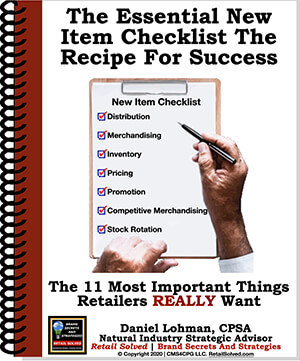You’ve been told that you need to purchase syndicated data to help support your brand at retail by the retailer, your broker, your investors, your distributor, etc. The question is what do you need and how do you use it?
Most brands think canned topline reports that rank their brand against other brands in the category is all they need. Spoiler alert, retailers already know how well your brand is performing in part because your competitors are sharing the same information when they discuss their performance with the retailer.
The challenge is that most of the topline canned reports are not actionable – they do not produce any actionable insights. For example, your sales may be growing in a category that is shrinking. Adding more items to the shelf may not be a good idea in that scenario.
For this reason, it's important to understand the power of the data and know how to use it to ascertain actionable business building insights. Actionable insights can help your brand stand out on the crowded shelf and will help you grow your sales and profits.
So, what kind of data do you really need? The buzzword in the industry is “big data.” So what is it and why should you care? Some definitions include every type of data source imaginable from point-of-sale (POS), shipment, syndicated, shopper loyalty, consumer, internal inventory, the cost of goods sold, demographic, social media, SEO, etc.
Together in the right combination, these data points can provide powerful insights to help you grow your business. It's not imperative that you adopt a big data strategy if you're new to category management. It is, however, important to understand the power of the data in every form and know how to use it to reach your goals.
Big data
The term big data frequently overwhelms brands, it sounds scary and complicated. It doesn't need to be. What's important is whatever you need to help you run your business. Similar to the expression, “you have to learn to walk before you can run”, true category management is starting slowly with the basics and building on them adopting new capabilities and strategies as you grow. You would not expect a pilot to fly a 747 before they learn to fly a jet, would you?
Big data in conventional/mainstream retail is dramatically different than what's available in the natural channel. The databases are more robust and more sophisticated. They are able to produce amazing reports and insights in the hands of a talented category manager. Some companies rely heavily on data automation for analysis and insights. While everyone would love to have push button analytics at their fingertips, the data does no good if you don't understand it or if it does not address your key business concerns. Nothing is more frustrating than spending hard-earned money on a series of complex and advanced reports when you can't get the insights you need out of them.
Here is where the years of education and experience for the 747 pilot pays off. A talented, well trained, category manager can deliver actionable insights well beyond any canned report. There needs to be a good balance between the technology and the experts who use it.
So where should you begin?
A good place for brands to start is with syndicated data. Syndicated data comes from retailer Point-Of-Sale (POS) systems known as cash registers. It identifies which items are sold and the price paid at the time of purchase by store within a week. Next, focus on the consumer, specifically who shops your category and how your brand solves their problems – meet their needs.
- First, seek to understand the health of your category and then identify the items that are growing and declining and why
- How long have the items been on the shelf, what is their history?
- What is causing the items to grow or decline?
- Are they promoted, how are they merchandised, where are they available, etc?
- Are they priced too high or too low?
- Are they out-of-stock often and how much?
- Next, compare the category to your competition. How well are you performing compared to them? Ask the same questions as above
- Now seek to understand why consumers shop the category
- What are their needs?
- What is important to them?
- What is their decision-making process?
- Do they choose brand before size, ingredients, etc?
- Incorporating shopper data at this point is key
- Shopper data can also include social media, etc
Canned topline reports are a great way to develop a familiarity and comfort with data. They are a good starting place but they will only help you with a basic analysis of a category. The key is to start somewhere and build on your understanding and use of the available data types. Always ask the question how do consumers shop and what influences them to buy.
Data and insights go hand-in-hand. They can make the difference between barely keeping the doors open and competing head-to-head with the largest brands on the planet.

Want A Competitive Edge? The Recipe For Success
New product innovation is the lifeblood of every brand. New products fuel sustainable growth, attract new shoppers and increase brand awareness. Know the critical steps to get your product on more retailer’s shelves and into the hands of more shoppers.
Empowering Brands | Raising The Bar
Ever wish you just had a roadmap? Well, now you do!
Don’t miss out on all of these FREE RESOURCES (strategic downloadable guides, podcast episodes, list of questions you need to be asking, and know the answers to, the weekly newsletter, articles, and tips of the week. You will also receive access to quick and easy online courses that teach you how to get your brand on the shelf, expand distribution, understand what retailers REALLY want, and address your most pressing challenges and questions.
All tools that you can use, AT NO CHARGE TO YOU, to save you valuable time and money and grow your sales today!
Image is the property of CMS4CPG LLC, distribution or reproduction is expressively prohibited.






